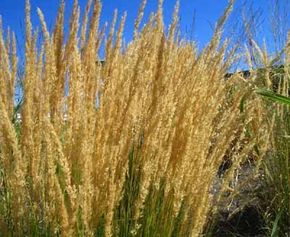- Cloud grass (Agrostis nebulosa) from Spain, growing to 15 inches tall, is grown primarily for its airy flower heads, which are much larger than the sparse foliage. The flower heads dry well but aren't suitable for dyeing.
- Wild oats (Avena sterilis) from the Mediterranean are now naturalized in the United States. Favored by flower arrangers, they're also a lovely feature in the garden, especially when light strikes from behind so that the hanging spikelets are highlighted. They grow up to 18 inches tall.
- Quaking grass (Briza maxima) from the Mediterranean was one of the first grasses grown for its ornamental value. The loose flower heads shake at the slightest breeze. They grow to less than 1 foot tall.
- Job's tears (Coix Lacryma-Jobi) from the tropics have large, tear-shaped grains that are used for making bead necklaces and other ornaments and crafts. As garden plants, they are grown for their seeds. They grow up to 3 feet tall.
- Golden top (Lamarkia aurea), another Mediterranean import, has erect, silky plumes on one side of the stalk like a toothbrush. The flower heads range from whitish to yellow and tones of purple. It grows up to 1 foot high; clumps are effective in the front of a border. It is very good for drying.
- Wheat grass (Triticum aestivum) grows to 3 feet tall and is topped with grains evenly spiraled around the stem. A cereal grain in real life (but not the common one we know), wheat grass is prized by floral arrangers.
Uses for ornamental grasses: Ornamental grasses are indispensable to many harvest arrangements, door hangings, and other crafts. The tall spiky kinds add line, and the feathery, soft heads of others provide a graceful note to arrangements. In the garden, plant grasses in clumps so their impact is heightened. Short varieties gracefully tie down the front of the border. Taller ones, unless their foliage is especially attractive, deserve middle of the border position where flower heads can be treasured beginning in July. Varieties grown only for flower arrangements can be planted in the cutting garden. Ornamental grasses are also showing up in container gardens, by themselves, or combined with flowers. In northern climates, many varieties of annual grasses remain attractive in the garden until heavy snows cover them.
